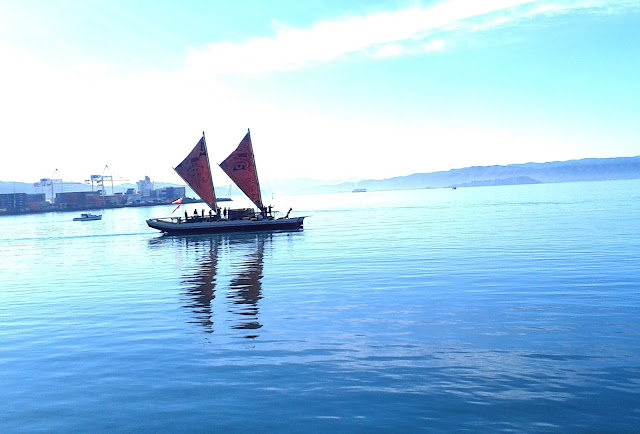 |
| The South Coast of Wellington on a fine winter's day |
The day dawned crisp and cold, but the sky was bright blue without a cloud in sight. If a cloud had been present, it would have hung decoratively in the sky as there was no wind to speak of to ruffle its edges and send it scudding. Clouds in Wellington normally are sprinters as they get bullied and harrassed by fierce northerlies and freezing southerlies.
I decided it was a day too good to waste and planned to 'Bike the Bays,' a pleasurable cycle around the harbour and south coast which is mainly flat. To finish off I would go up Happy Valley Road which is a long gradual climb, then up Raroa Road which is a stiff steep climb. To complete the circuit from there involved a few rolling hills through the suburbs.
A brisk descent down Ngaio Gorge made me grateful for my winter gloves and arm and leg warmers. I had noted my shoe clips were wearing thin so stopped at a handy cycle shop to have them replaced. When I first started wearing them I took a few tumbles as I practised the art of clipping and unclipping but now they are second nature. The bike shop boys always tut tut at the state of my clips and tell me not to walk on them - but how else am I supposed to get into coffee shops?
Once sorted I headed around the waterfront and Oriental Bay. Needing a comfort spot I went into one of the changing sheds frequented by bathers in the summer. To my surprise an elderly lady was in the process of changing after a swim. Air temperature was around ten degrees Celsius and the waters of Wellington Harbour are cold no matter the season.
'Did you have a good swim?' I asked.
'Yes,' she replied standing there in her altogether without a care in the world.
'Do you use a wet suit?' I asked.
'What would you want one of those for?' she replied.
I commented on the fact most people had stopped swimming for the winter, including myself. She commented on how soft people were these days, especially young people. I had to agree with her, and mentally decided to have a winter swim to test my softness out - but with a wet suit. I had swum in summer with a wet suit and a double layer of bathing caps but chose not to mention this!
Back on my bike I continued around the Bays till I reached The Chocolate Fish, a great cafe tucked in a sheltered spot at Shelly Bay. I had a lovely fish chowder while watching children play on the push-alongs, trikes and scooters that are made available to keep them occupied while their parents dine and chat. Today adults were in on the action as much as the kids.
 |
| Big kids and little kids enjoying the ride on toys at the Chocolate Fish |
Once over the Passa Branda I was exposed to the South Coast and more wild seas. It was chopped up around the airport and once through the tunnel I stopped to watch the surfers trying their luck on big waves that were not holding up too well but giving some excitement. I observed they were all in wet suits and some had neoprene bonnets as well. Thinking of the lady I had recently talked to, I had a chuckle to myself as I watched the cosseted group in front of me.
Surfers togged up in their neoprene at Lyall Bay
The surf was definitely up and gave a great display as I pedalled on my way. White frothy spray climbed into the air as the waves crashed into rocks. Tapu te Ranga the island Island Bay is named after was copping the brunt of it. In its lee a little boat sheltered, reminding me of Rita Angus's well known painting.
 |
| Boats, Island Bay. Rita Angus |
 |
| Tapu te Ranga protecting Island Bay from the rigours of Cook Strait |
Tapu te Ranga has long history. In ancient times Kupe the great explorer is said to have climbed to the top of the island to spy Te Wheke- o -Muturangi, a giant octopus which he then chased across Cook Strait and finally slaughtered. He had chased it all the way to New Zealand from Hawaiki.

 |
| Kupe killing Te Wheke o Muturangi
|
In the 1820s it became a refuge for the last of the Ngati Ira as Te Atiawa and Ngati Toa came rampaging through having been displaced themselves from Taranaki and Kawhia by more Northern tribes who had obtained the musket causing a huge upset in the balance of power. Very few Ngati Ira remain as a result and Wellington is claimed mainly by Te Atiawa.
I took it slowly up Happy Valley Road, then whizzed down Brooklyn Road - always a pleasure as there is plenty of space and broad sweeping corners. The alternative - Ohiro Road by contrast is steep, winding and narrow, and traffic flows both ways. Actually, there isn't room for flow - cars proceed cautiously and have to manoeuvre around each other as there is little room to pass. Biking up it is a tough grind and biking down is done with caution and brakes in good condition.
I took my time up Raroa Road, rolled over the rolling hills through Wilton and arrived home in good time having enjoyed the brilliant blue skies of a clear winter's day.




































